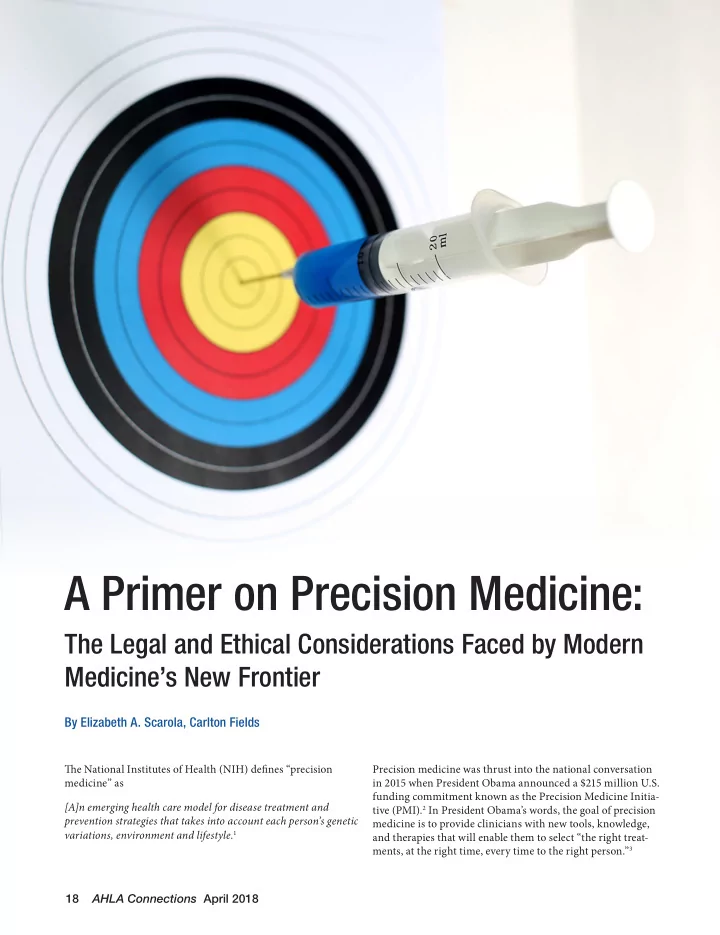

A Primer on Precision Medicine: The Legal and Ethical Considerations Faced by Modern Medicine’s New Frontier By Elizabeth A. Scarola, Carlton Fields Tie National Institutes of Health (NIH) defjnes “precision Precision medicine was thrust into the national conversation medicine” as in 2015 when President Obama announced a $215 million U.S. funding commitment known as the Precision Medicine Initia- [A]n emerging health care model for disease treatment and tive (PMI). 2 In President Obama’s words, the goal of precision prevention strategies that takes into account each person’s genetic medicine is to provide clinicians with new tools, knowledge, variations, environment and lifestyle. 1 and therapies that will enable them to select “the right treat- ments, at the right time, every time to the right person.” 3 18 AHLA Connections April 2018
can sequence an entire human genome in less than 24 hours for just under $1,000. 10 For less than $200, 23andMe ofgers Though scientists disagree consumers “genetic health risk reports” that detect variants related to late-onset Alzheimer’s disease, Parkinson’s disease, about the extent to which alpha-1 antitrypsin defjciency, celiac disease, hereditary hemochromatosis, hereditary thrombophilia, and age-related macular degeneration. 11 precision medicine will Targeted Therapeutics translate into genuine Even more astounding is that scientists can now ofger certain patients targeted treatments for a variety of illnesses and condi- tions. 12 Tiese targeted therapeutics provide medicines specifjed improvements in health to treat individual genetic mutations with exactitude. 13 Tie Food and Drug Administration (FDA) has approved a number of these medications. 14 To name a few, targeted therapeutics are now care delivery, even the most made available for certain breast cancers, melanomas, colorectal cancers, leukemias, lymphomas, ovarian cancers, pancreatic skeptical of experts cannot cancers, rheumatoid arthritis, and lupus conditions. 15 In addition, recent advances in Clustered Regularly Inter- spersed Short Tandem Repeat (CRISPR) technology now allow deny recent advancements scientists to artifjcially alter genes; the promise of CRISPR technology knows no bounds. 16 in genetic testing and Precision medicine’s emergence in modern day medicine is here; and, the potential that the fjeld ofgers is vast. However, its promise must manifest itself within our current legal and targeted therapeutics. regulatory system; and, as every health care attorney knows, innovation is ofuen fraught with complex and sometimes novel legal and regulatory barriers. Pre-Market Approval and Clinical Oversight: PMI drastically expanded precision medicine’s presence in FDA and CMS scientifjc research. As evidence, later this year, the PMI cohort program, “All of Us,” will begin enrolling participants in a million person data set of genetic, lifestyle, and health infor- [T]he FDA is currently fjnding its regulatory foothold during mation for further study of the interaction of genetics, environ- [this] transition in the practice of medicine. 17 ment, and lifestyle. 4 Tiough scientists disagree about the extent to which Two federal regulatory agencies currently oversee the develop- precision medicine will translate into genuine improvements in ment of genetic diagnostic tests and targeted therapeutics: the health care delivery, even the most skeptical of experts cannot FDA and the Centers for Medicare & Medicaid Services (CMS). deny recent advancements in genetic testing and targeted ther- Tie FDA is responsible for protecting and promoting public apeutics. 5 health by assuring “the safety, efgectiveness, [and] quality” of medical drugs and devices by the authority granted to it under the Federal Food, Drug and Cosmetic Act (FDCA) and the Genetic Testing Medical Device Amendments of 1976. 18 Consequently, the FDA Laboratories across the world assess risk and diagnose disease is a gatekeeper to advances in precision medicine. by analyzing genomes. 6 Tie advent of 23andMe and other For example, the FDA regulates in vitro diagnostic tests direct-to-consumer genetic testing products permit patients (IVDs) as a subset of medical devices. 19 FDA approval of from their homes and personal computers to identify and assess medical devices typically requires analytical and clinical their unique risk of developing disease. 7 validation. 20 In the case of IVDs, manufacturers must prove Although early genetic tests were developed to detect rare, that an IVD can (1) accurately identify a sample (i.e., accurately relatively straightforward single-gene variations that were read a specifjc set of DNA bases in the human genome) and (2) highly correlated with specifjc diseases, today’s genetic tests link particular genetic variants to specifjc diseases (i.e., provide (e.g., next generation sequencing (NGS)) are able to detect meaningful clinical information). 21 Tiough this regulatory a wide range of genetic variants from a single sample. 8 NGS threshold seems simple enough, a narrow interpretation of the allows scientists to identify more common, complex diseases pre-market approval regulatory framework could lead to an and provides patients information to assess their individual risk unintended absurdity: namely that because the FDA typically of developing a myriad of diseases. 9 In 2018, a single laboratory bases its pre-market approval decision on evidence dependent healthlawyers.org 19
Recommend
More recommend